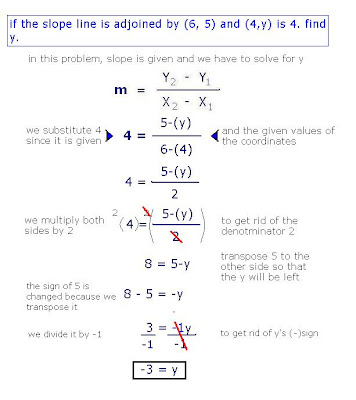Hello there Gummy Bears!!!
Today, instead of t
he usual lectures, we are told to play a game using strings and pieces of tape. The game required us (in pairs) to graph a line in the “huge coordinate plane floor” using only the slope given.
Again, don’t forget the formula: rise/runFor example: The given slope is
½. To graph a linear equation, we use the slope given to make a line perpendicular to it. Locate the rise which is
+1 and then locate the run which is
+2.

Now we can draw the line through the points. Since I am finding it quite difficult to emphasize the different points on this graph, I am giving you the liberty to do it by yourselves.
You can easily illustrate the slope on the graph, depending on the information you have about the line and the equation.

Having used most of our time today in playing the game, I would like to share some things about the topic from my browsing. Many people describe "slope" as a measure of the "steepness" of a line. Look at the two graphs below. Which line has a larger slope? Which line appears to be steeper? Explain what is happening.
 Solution:
Solution:Graph A has a larger slope, even though graph B appears steeper. This appearance is caused by the different scale used in the two graphs. If it were placed on the other scale, the line in graph B would appear nearly flat!
I have also added a
great video in case you didn’t fully understand what I’m trying to tell here…
Finally, I was able to do something for my assigned task today BUT I am not sure whether I did justice to it. Hahaha…..
And now, it’s my turn to pass on the TORCH. Choosing…thinking whom to choose…
Finally, the next blogger will be
Ian!!!








 *
*





































